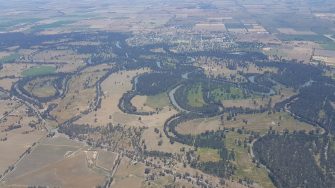
Date: Wednesday, October 31, 2018
Project: Eastern Australian Waterbird Survey
Observer: Richard Kingsford
Today was the start of the River Murray survey. After leaving Sydney, we picked up Terry, our other observer in Canberra, and headed for Albury. Shannon was also along on a training run. Hume Dam was showing the impact of the drought, dried right back from its normal full level. From here it was head west along the sinuous river with its billabongs.
Part of Hume Dam which regulates flows in the River Murray
The meandering River Murray just west of Albury
Our first count was on Lake Mulwala, the large weir pool, created when Yarrawonga Weir was built, allowing water to be diverted down Mulwala canal to major irrigation areas to the north of the river. Here the trees are long dead, water logged. The waterbirds are always few and far between for such a big body of water – just a few pelicans, swans, black duck and cormorants.
Surveying Lake Mulwala with its dead trees
Then it was on to the Barmah-Millewa Forest – the two of us, who have been doing this survey for more than a decade, couldn’t remember the system looking drier. Lagoons that are normally full were dry, with most water just confined to Barmah Lake and Moira Lake, and a few nearby swamps apart from the main channel of the river. There was also some water under the river red gum forest in patches, indicative of an environmental flow.
Surveying Reedy Swamp, usually full of water but only a patch confined to an area just in front of the bird hide
Contrasting dry and recently wet patch in Reed Swamp
There were few waterbirds, even on the small areas of water. Interestingly, white ibis were in groups indicative of an intent to nest but there was no sign of any nesting birds. On the Barmah National Park side of the river, that’s Victoria, we saw at least about 30 horses. Another first, we have never seen as many horses in this wetland.
Wetland areas of Barmah National Park, with horses
Horses running through wetlands in Barmah National Park in Victoria
Surveying Barmah Lake
Once we had finished zig-zagging across all of the small wetlands in the Barmah-Millewa Forest, counting each twice, we headed west to survey the Koondrook-Pericoota red gum forest. This never has many waterbirds and it was no different today. From here we headed to the Hattah-Kulkyne Lakes National Park. Last year there was water everywhere, with most of the lakes full, but this year about half the lakes still had water. The deeper lakes had a few pelicans and cormorants while there were quite high densities of lots of species of waterbirds on the shallow lakes, including pink-eared duck, grey teal, pied stilts and black duck.
Surveying on of the Hattah lakes
We finally finished, about four hours later after leaving Albury, surveying another small stretch of the River Murray, east of Mildura. These parts of the river have a few cormorants, the odd black duck and wood ducks but they aren’t particularly good habitat for waterbirds. There are striking irrigation areas on either side of the river. We spent the night in Mildura.
Surveying the River Murray
Surveying the River Murray for waterbirds
Irrigation areas near Mildura
